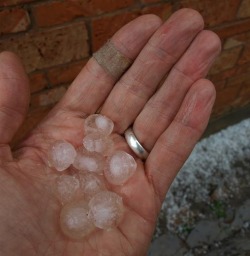 Hailstones, some nearly 2cm in diameter We've had some pretty heavy rain here over the past few days, which culminated on Tuesday with the darkest daytime skies and windiest thunderstorm we've ever experienced in Simao. For 10 minutes giant hailstones fell from the sky and the temperature dropped about 5 degrees. It was no surprise to find out that it's all to do with the artificial cloud-seeding that's been going on all over Yunnan since Sunday. Batteries of rockets containing silver iodide were fired into potentially rain-bearing clouds in an attempt to provide a nucleus for the rain to form on and so stimulate a downpour. In Xishuangbanna and Simao prefectures this seems to have worked pretty well, but further north in the areas worst affected by the drought the induced rainfall wasn't nearly as heavy or prolonged. People here don't seem to be that bowled over by the technology or the ethical considerations (or adverse side-effects, such as crops being destroyed by falling marbles of ice!) of tampering with nature. After all, China has a long history of battling with elemental forces (the taming of the flood-prone Yangtze and Yellow rivers springs to mind) and folk are used to their lives being controlled by the government, to a much greater extent than we experience or would tolerate in the UK! To publically question the worth of this weather modification is not even considered.
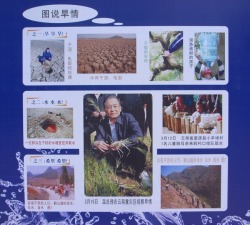 The recent wet weather has prompted a long overdue blog entry about the drought which has struck Yunnan (and 5 other SW provinces) in the past few months. Some parts of Yunnan have been particularly badly hit by the lack of winter rainfall and hot sunny weather. In Baoshan many crops have failed - not just annual wheat, but valuable resources like fruit trees, coffee plants and tea bushes which will take years to replace. As usual, it's the folk in the countryside who have suffered most, as water from reservoirs is diverted to the taps of the major urban areas (where the rich and powerful live). At times like this it's cuddly Wen Jiabao (see above), China's president, who's wheeled out to look concerned and caring, a role he perfected during the Wenchuan earthquake response. This poster board appeared in the College recently, showing images of the drought and urging students to conserve water and electricity. How has the drought affected us here in Simao? Well, not much - certainly no water rationing or water price rises. But we did have to go without electricity for a whole two days (between 7am and 10pm) a couple of weeks ago. Yunnan's normally productive hydroelectric power stations are running at hugely reduced capacity (or have closed down) as the river levels have dropped to alarmingly low levels. We've even stopped exporting electricity to Guangdong province in the south. It leaves us wondering though if the great South-North Water Project is ever going to work. This master plan, on an even greater scale than the 3 Gorges Dam, involves transporting water in huge tunnels from the great rivers of China's south to the water-hungry northern provinces and Beijing. It could be that water resources are going to be a major issue in China's economic future, even more so than coal, oil or iron ore.
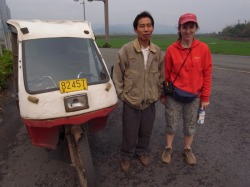 We took to the road again this weekend, in search of a traditional Dai nationality village. Ali had spotted one from the bus journey down the highway to Jinghong last week. We figured it wouldn't be that hard to hop off the bus to investigate. Our plan was fine, except the Pu Wen (nearest town) bus took a different route, with the final 11 km on the old road. The scenery was beautiful but it left us with a 3-km walk. To save our legs we all hopped in this san lun motuo che for 10 RMB. Mr Ai was a careful and slow driver - perhaps necessitated by the excessive weight and small engine.
Our arrival in the village left me a little disappointed as the houses on the outskirts had been surrounded by red brick, broken glass-topped walls. The traditional tiled Dai rooftops were visible but nothing else. We continued along some winding lanes, where we met an older lady wearing the characteristic long dai skirt and head gear. It was like she was waiting for us, pulling out bamboo stools for us to sit on outside her barn. We chatted about the village (there are about 40 houses in total an a population of just over 200), their livelihoods (mostly tea, coffee, rubber and dama...marjuana!) and met some of the local youths. When I asked the young men what jobs they have, they replied: "We don't have jobs, we just farm." It's hard work that earns a basic living, but there's no salary or job security. It's seen a way of life, not a job.
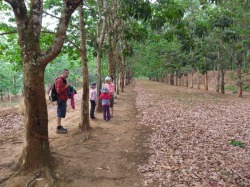 On our exploration of the agricultural land around the village of Meng Mo, we found ourselves in a large rubber plantation. Most of the sap-collecting bowls had been emptied or removed, but we still had fun peeling strips of rubber from the drainage grooves. We made some rubber bands and Ali rolled a long, thin string into a bouncy ball. This week's home school project is, of course, RUBBER - where it comes from, how it's processed and what it's used for.
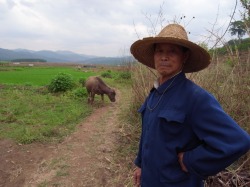 The highlight of the trip for me was meeting the local people, including Buffalo Man. He's seventy-six years old and comes from Meng Mo village, where he lives with his wife, son, daughter-in-law and two grandsons, the eldest of whom is twenty years old. He says he's in good health after giving up smoking when we was fifty, due to chest problems. He was tending his young buffalo, bought recently for 2,200 RMB (my monthly allowance, and probably twice the monthly income of a farmer). At a year and a half old it's now ready to work and they should get twenty years of labour out of it. It's already been castrated so is easily to handle. You might wonder how I gleened that information, as "castration" isn't in my active vocabularly. Simple: "Um, ah, mmm....can it have babies?" [accompanied by a chopping movement with my arm]. He immediately understood and told me they always castrate them for working, otherwise they are difficult to handle in the plough.
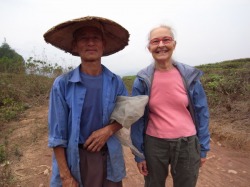 Sue with a local farmer who was out foraging for plants. His rain hat is handmade, from bamboo leaves. We've all be invited back for the Dai Water Splashing Festival, which they will celebrate in the village from the 9th - 11th April.
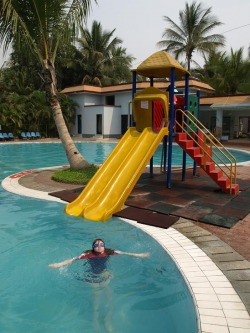 Tuesday's homeschool swimming lesson took place in Jinghong, a 2-hour bus ride south of Simao! First off was a visit to the Meimei Cafe for an early lunch - burger and chips (each) - then the swimming pool at the Crown Hotel. We were last here (at this particular pool) with Alex, Elspeth and Katie in the summer of 2006 (seems a long time ago now!) so it was good to be back. Since then a new water slide has appeared and the girls had great fun, along with their Barbies. We also slipped in some diving lessons for Freda. By 4pm we'd had enough, staggered out for an icecream, then ended up at a local market where we picked up some interesting snackfood for the journey home (see below). Edie fell asleep almost instantly on the bus, but the journey was made more exciting by a police search of our vehicle (a semi-regular occurrence at the Simao tollgate). We're very close to the Golden Triangle here, and Simao is the first main city on the drug-running route between Burma (via Menglian) or Laos (via Mengma/Jinghong) and China. The police hauled off one poor guy (admittedly he looked a bit dodgy and drugged up) who we never saw again, and proceeded to empty the bus and inspect all the bags in the boot. Luckily we didn't have any luggage so simply melted away into the night and picked up a no.1 bus into town. A late night...
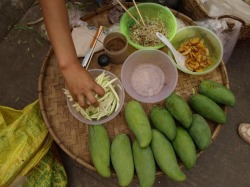 Jinghong's street food is a little more exotic than Simao's thanks to the presence of the Dai ethnic nationality in the area. Dai food is based on sour and chilli flavours, with plenty of fish (usually bbq), dried beef, bamboo, lemongrass and more exotic dishes such as fried river moss and yellow ants eggs. Pictured above is the classic south Yunnan snack "suan manguo" - sour green mango with chilli and salt. Jinghong folk seem to like their mango shredded; in Simao we tend to see it cut into bitesize chunks.
Another popular streetfood setup is the sticky rice mini-meal (see picture below). You buy a bag of delicious "nuomi" (sticky rice) and choose from a selection of accompaniments: thick bacon slices; pickled vegetables ("yancai"); shredded wind dried beef ("niuganba"); salted chillied fermented soyabeans; reed packets of meat and tofu; and (a new one for me, after years of searching...!) the elusive and iconic fried river moss. It didn't disappoint - green and salty, a well worth the wait!
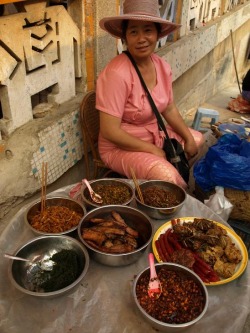 Dai snacks - moss is front left
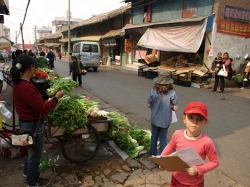 Monday's homeschool was a trip round the older streets of Simao. Lesley made a ticklist booklet and Freda and Edie's job, clipboards in hand, was to spot as many wells, adobe houses, temples, and "old things" as they were able. On a diversion to Fuxin Market we ended up having a lesson in food production too! The Chinese are fanatical about their meat being fresh, so in a Chinese market you don't see fillets of fish on ice or neatly packaged polystyrene packages of chicken breasts or drumsticks - far from it! Fish are bought live, as are most chickens.
 Once you've bought your chicken, you either carry it home by the ankles to despatch it yourself or take it along to the "chicken slaughtering shop" - there's one at every market. Here, for a small fee, your fowl will be killed (knife to the throat), plucked (boiling water speeds up the process), gutted and returned to you whole in a plastic bag along with offal, proto-eggs and a small bag of watered down and salted blood. The blood is an essential ingredient of the soup which will be prepared...
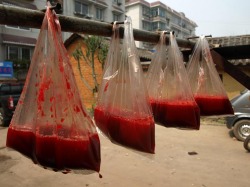 So a good educational experience for the girls! Actually they're pretty well aware of where their food comes from already. Only last weekend, on a visit to Lao Yang's grandad in the countryside, Freda had to hold the chicken's wings while its throat was cut. Then she and Lao Yang got stuck into making the soup. Later she ate honey from honeycombs(still reeking of smoke from the collection process) gathered by grandad from the forest. But that's another story...
 Tea pickers by our little tu lu (earth path) around Xi Ma Lake. They had another half hour of picking in the burning sun before heading home for lunch and a nap. 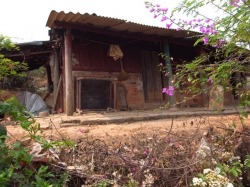 On Sunday we went exploring - a kind of 'spot the difference' outing to the new campus and xi ma (Wash Horse) Lake. We made the same trip last year and wanted to see how the campus was coming along. What we didn't expect was to see so many changes around the lake itself. The new road is encroaching and more of the traditional dwellings [see picture] have been abandonned. Despite the noise, gravel, dust and urbanisation of Simao's tea hills, we had a lovely outing. Sue and Nini (Hou Wanxia's daughter) came too, to view where they will be living in six months, when the College finally moves.
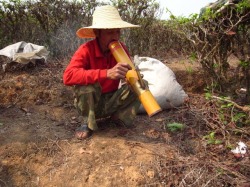 Not all tradition is being eradicated. By the shores of the lake we met this tea picker, having a mid-afternoon smoke of his yan tong, one of Yunnan's '18 oddities'. This small, light, travel-size version of the pipe can be bought at the market for around 10 yuan. If we had access to Youtube I could post a short video clip of the smoking process - tobacco leaves stuffed into spout, water bubbling as he inhales, clouds of smoke around his face. Apparantly the water filter system renders this process more healthy (or does that mean 'less unhealthy') than smoking a cigarette.
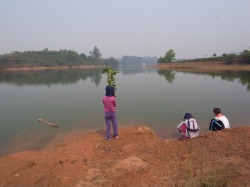 Freda, Edie and Lao Yang enjoyed playing on the muddy shores of Xi Ma. Edie was frustrated not to be able to launch her bamboo boat, due to lack of wind and current. Flapping at it with a branch only ended up in her spraying the others with water. The highlight for the gang was slurping around in mud collecting tadpoles, in a small inlet we found later. The tadpoles are now occupying our home school habitat box and we shall chart their metamorphosis over the next few weeks. We discovered last year that it's always wise to release them (especially if they are in the house) just before the final 'swim to leap' transition.
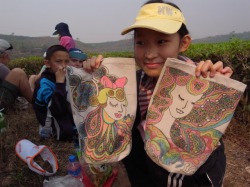 At Christmas time, just before we left for Scotland, we gave Nini several boxes of fabric pens and some undecorated small, canvas sacs. During our picnic stop Nini modestly drew these beautiful creations out of her bag, bulging with snacks. Before the end of the picnic she gave me the one on the right, which now holds my knitting wool. Since we first met Nini over 4 years ago she has loved drawing, usually intricate, emotive sketches of people. Having also decorated a larger bag, the pens have now dried up, much to her disappointment. We've never seen fabric pens in China but I shall keep hunting.
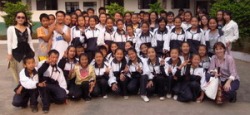 Lesley with Class 122 Two of our Grade 3 students attended the Team Leader-Trainer training course closing meeting last term, with some of their middle school students. They had completed their teaching practice at this school and found that the students responded well to their communicative methods and student-centred approaches. They shared their experiences with the Team Leader-Trainers and I promised to visit the school to meet their classmates. I finally made it yesterday and Sue came too.
Although we were all piled into the classroom for a 'meet and greet' session, it was fairly informal. We introduced ourselves, showed photos, asked and answered questions and generally got a feel for the teaching and learning environment. As usual, the children were lively and excited in the playground, but instantly settled into a fairly passive classroom mode once inside. Fortunately there were a few noisy, energetic children who couldn't contain their excitement and kept the momentum going. It's always easy to pick out the students that the teachers normally rely on to answer questions. They are the first to call out, put their hands up and come to the blackboard. What's more, the other students usually look at them, waiting for them to answer. It was a shock to some of the students not to be ignored, especially some of the boys at the back who, I sense, are used to being spectators.
Nevertheless, the children did really well. They were attentive and tried hard to understand and follow our short activities. While some of the students didn't understand what was going on at times, there were absolutely no discipline problems. I'm not sure if the same would be true if a Chinese visitor confused and perplexed a group of British teenagers mid-afternoon.
Sue and I were asked students to sign autographs for the students. The first time students asked me to sign my name I felt really uncomfortable, a feeling Sue also expressed yesterday. I still think it strange that my name should be so special or valuable to them. It's a humbling experience. I don't feel so uncomfortable now but still embarassed that they should think me so important. I know, however, that the students appreciate the gesture. I usually add a happy face or words of encouragement, to make the scribble a bit more meaningful.
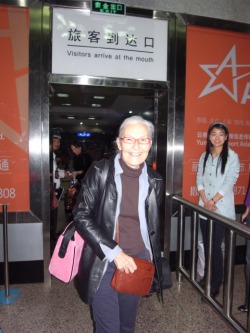 We were very excited at the weekend, due to the arrival of Sue Anderson, the latest VSO volunteer to come to Simao. We accompanied Chen Yong to collect Sue from the airport - where she arrived at "the mouth" [see great Chinglish sign above] - before going out for some noodles. Sue, also part of VSO's Basic Education programme, will be working on the PIE teacher training, follow-up and any other projects that take her fancy. There's plenty work to go around.
Sue, from England, spent nearly three years as a VSO volunteer in Rwanda from 2001 to 2004. She worked as a teacher trainer at the Institute of Education in Kigali. Sue says: "I'm impressed by Simao. It's a pretty town with lots of facilities and I'm going to be very happy here.....once I get my flat!" There are still a few things to sort out....
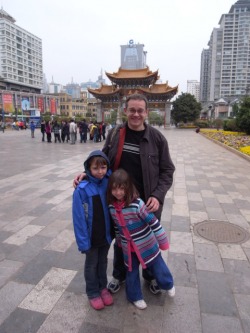 Paul, Freda and Edie in Kunming On arriving in China we parted company in Beijing. Ali flew with the girls to Kunming and I went to Xi'an, to join the annual VSO conference. This was a great opportunity to to catch up with friends in placements scattered around Yunnan, Gansu and Shaanxi, as well as in Beijing. I even had a couple of swims in the hotel pool. Xi'an was grey and wet as usual (for me) so I was pleased to hop on a plane to head South. I joined up with EAF in Kunming, where we had some time exploring the old town and eating noodles with Paul.
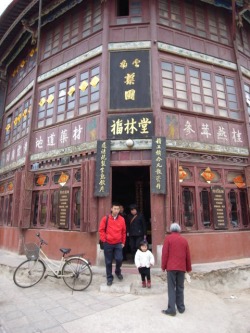 Old town pharmacy Top of our agenda was to track down an old pharmacy Ali had spotted years ago. It is one of the few old builings still in use in the old town, which is being demolished and rebuilt. As it happens, many of the new buildings that are being erected are true to traditional architecture and will be a lot safer than the old ones, while maintaining the character of this part of Kunming. This pharmacy, which is over 100 years old, is in unusually good condition so may actually get to remain standing.
This couple are clinging onto their pet shop-cum-corner shop in the old town as the buildings around them crumble and fall. There are still signs of people living in the upstairs room on the right [with bars] but the front door is far from secure. The residents have no choice but to leave, though their prospects for relocation are limited. In Simao many people are forced to buy flats that they could barely afford, even subsidised, when their danwei (work unit) chooses to move.
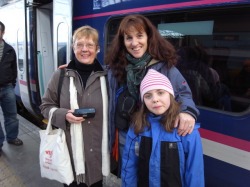 Helen, Lesley and Freda the platform We left the Black Isle on the 2nd of March, seen off from Inverness railway station by a good friend, Helen. I went to school with Helen's daughter, also Lesley, who now lives in Sydney with her Australian husband, Steve. Despite being determined to 'travel light' we still had a number of suitcases full of food treats and toileteries - mostly consumables to see us through the coming months.
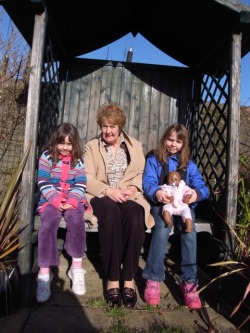 Edie, Elspeth and Freda in Aberdeen Before finally leaving the UK we spent a couple of days with Ali's parents, Alex and Elspeth, in Aberdeen. I caught up with a few friends at the University while Ali and Alex had a day skiing at the Lecht. Freda and Edie enjoyed playing with the newly-refurbished dolls' house and accompanied Granny to the hairdresser. Packing and unpacking gets practically easier but emotionally harder for me. What do we take, what do we leave behind? Although our bags contain clothes, food and books for home school - all of which are very useful - I still wonder if, one day, we could just take off with a monk's bag over our shoulder. We have given up so many of our materials possessions - either sold, given away or stored in an attic - but it's hard to give up all. In fact, Freda and Edie have decided to take Baby Annabell them this time. She's the largest toy they have but, having been stored at Craiglea for five years, it seems better she gets some use before they grow out of her. They take great delight in the faces of passers by, who can't work out if she's real or not.
|
